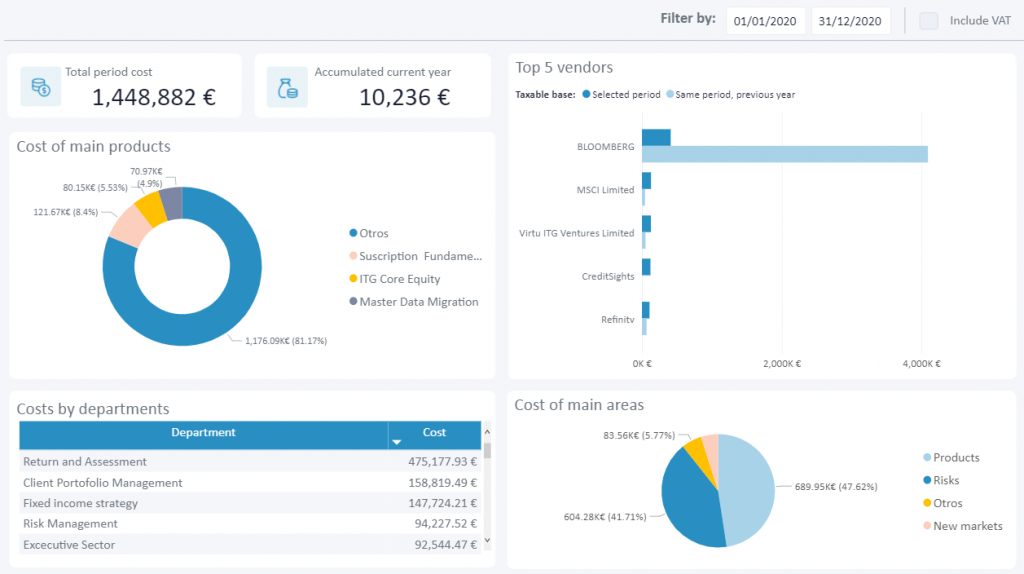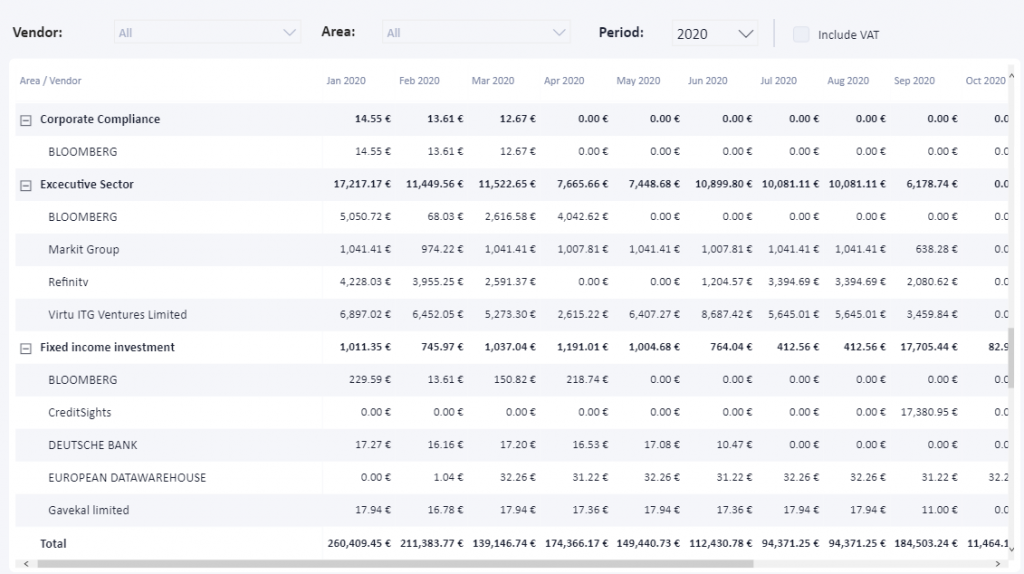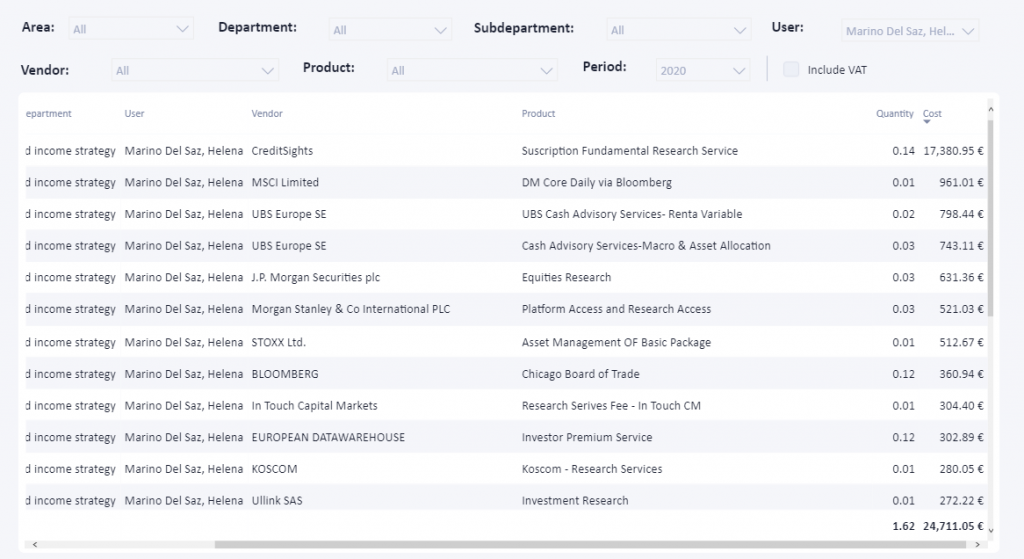As we have stated on previous occasions, costs of sources of information are considered one of the main costs in financial entities. Usually, they follow personal and eventually building costs.
Before we analyze the reasons why consumers are considered key figures in costs optimization and budgeting, we would like to provide some context.
Market Data Management
In many financial entities, the figure of market data manager does not exist per se. The report of information sources is carried out by different profiles that vary from IT departments to business consumers. Hence, they are people who provide support to the business on a regular basis, and that, in best scenarios, analyze information sources once all different tasks have been performed. As a result, there is no effective and proactive source information management. On one hand, as a consequence of lack of time, and on the other, as lack of specialization. If source information management is directed only to “damp down the fire” or to answer requests, it is hardly possible that we acquire expertise on source information.
Market Data Management involves three main structures:
- Costs control and management.
- Allocation control.
- Usage control.
In this post, we will focus mainly on the first structure: costs control and management.
The main aspects of the management and control of market data costs
In general, costs control and management are made up of four main aspects:
- Signed Contracts Management: it covers information over suppliers, completion date, included products, and general conditions.
- Assignations Management: it establishes to whom is assigned each of the subscribed products.
- Invoice Management.
- Budgeting.

In order to optimize costs, it is important not to lose sight of these aspects. In the following paragraphs, we will offer some guidelines for each aspect.
- Contracts Management: It is advisable to develop proactive management of contracts. Most of the time, contracts are renewed in an automatic way without previous analysis; hence, leaving aside the possibility to consider better conditions. In some cases, this is not possible as there is a “monopoly” of some suppliers over specific contents, but in other cases, it is. It is very important to understand which are the real necessities that the users have in terms of the information that they require. There may exist the possibility to find alternative services for a more convenient price, or else, to maintain the same service for a lower cost.
- Assignations Management: It is important to recognize the people, areas, and departments to whom the subscribed products are assigned. In other words, it is important to know who is responsible for the service and who will bear its cost.
- Invoice Management: Invoices issued by suppliers of source information must be analyzed by the company in order to know if differences in invoice amounts are explained by price changes, an increase of the products hired, or currency fluctuations.
- Budgeting: When it comes to costs of data feeds it is important to be transparent since, on one hand, it allows the entity to consider the aspects that can be addressed to optimize costs; and on the other, since it allows the analysis of each month separately in order to be aware of deviations. By doing so, proactive rather than reactive decisions can be made.

Data Feeds Consumers as Key Figures in Costs Optimization
Most of the time, in financial entities, data feeds consumers are perceived as users that request information and terminals without being aware of their costs. This perception is based on the argument that, as they carry out the business, they must have the best of what the market offers. However, this is not the case. Users request the information and the products they believe are necessary in order to develop their work efficiently.
In order to improve market data management, it is of vital importance that the people responsible for this management be able to incorporate more and more consumers and business managers in the process. By doing so, users’ real necessities can be understood and assessed accurately.
For this implication to be efficient, and to result in the optimization of sources of information, it is crucial that users can access information that allows them to make decisions:
- Assigned Products:
- On many occasions, users are not aware of all the products they have been assigned, that is to say, that they are paying for. Sometimes, the user requested a product in the past for a particular reason, and in the present, he is no longer using it, but he is still paying for it.
- Cost of Assigned Products:
- In addition, it is important that consumers be aware of the cost that each assigned product has. Furthermore, it is relevant that they know if the amount they are paying is similar to the amount paid by other consumers in their department. In case this amount is inferior or superior, consumers should know if their activity justifies the difference in costs.
- Alternative Products:
- If there is transparency over the usage of data, the person responsible for market data should be able to offer alternative products that cover the same necessity for a lower price or even to consider better conditions for the same price.
Getting data feeds consumers involved in the costs optimization process allows them to recognize their necessities based, for instance, on their actual assignations and payments. Once each user has validated their information at a personal level, the department manager may verify the requests or may make appropriate decisions so as to adjust their contract to the specific necessities of his department and budget.
Market data consumers and managers must feel like a united group working in favor of cost optimization, they should never work against the quality of the user’s services.
In order to carry out transparent and efficient management of data, it is advisable to develop effective management of data feeds costs. Beforehand, this may appear to be an easy task. However, most of the time it is difficult to carry it out since, going back to what we have previously stated, in many entities, marked data management is a passive process rather than a proactive one, as a result of lack of time.

Market Data Managers as Consumer Allies
In many entities, market data managers are considered “villains” who only intend to cut down on costs.
If market data managers were able to delegate administrative tasks in order to concentrate on achieving greater insight on the user’s necessities as well as on the supplier’s offers, wouldn’t it be valuable for them as individuals and as professionals? wouldn’t it valuable to data consumers? wouldn’t it increase the added value of the entity?
More and more entities on an international scale are delegating basic cost management of market data to specialized companies. By doing so, they get their employees to focus on analyzing rather than processing the data, in order to get information useful to decision-making in terms of cost optimization and data suppliers management.
Nowadays, in the market of market data costs management, there are some solutions, for less than 1.000 euros per month*… , that give entities the possibility to access a service processing its invoices and providing clear and updated monthly information over costs for each vendor, area, department, country, or person.
By resorting to these types of services the company is secure of having updated information, and also of being able to offer full transparency to its users when it comes to contracts and assigned products. All of which facilitates the process of reaching consensus in cost optimization as well as the realization of budgets.
In MedySIF we have been helping financial entities to improve their cost management of sources information for years. Do not hesitate to contact us if you have any questions after having read this article. We will be glad if our expertise can help you to focus your’s as well as your team’s activity on the things that can increase added value.
* These costs may vary depending on the size of the company and its necessities.


